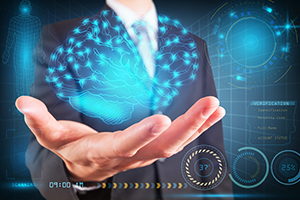Four ways the next wave of tech will keep you happy and healthy
What if your next healthcare appointment wasn’t with a doctor, but with an algorithm? In fact, it just might be. Digital transformation in healthcare is accelerating and AI-powered treatment is no longer a science fiction. The events of 2020 have exacerbated some major trends in care delivery that were already in motion, and soon, technology will play a fundamental role in keeping us healthy and happy.
Here are four of the biggest digital health trends we’re seeing in 2021:
1. Big data analysis & machine learning
Tech is now giving physicians, healthcare institutions and insurers more data on our health than, just five years ago, was even imaginable. Wearables, connected devices, apps and other digital tools can monitor health data ranging from sleep and posture to blood oxygen levels and body temperature, 24 hours a day and in real time - all stored in a single, secure electronic health record (EHR).
This huge influx of data creates a new role for data science in healthcare, with big data analysis, powered by machine learning, able to identify trends across large patient groups and also give individual patients a much deeper understanding of their general health, any health risks they might be facing, and the efficacy of their treatments.
2. Telemedicine on demand
Technology is transforming the way patients communicate with healthcare professionals. Even before the pandemic, physicians were increasingly conducting appointments through video conferencing software like Zoom or through specialist apps, which enable patients to see their doctor from the comfort of their own home - or, indeed, anywhere else they happen to be. The need to avoid in-person appointments during the pandemic has brought these tools into much wider use, which frees up physicians’ time, reduces costs and keeps patients more engaged with their own health.
There’s an element of behavioural science in play here; by making it more convenient and, crucially, easy to speak to a doctor, people are more likely to do so, which means preventive action can be taken more quickly should it be needed. At the same time, telemedicine complements face to face care being delivered in patients’ homes; being able to access vital, in-person support from a healthcare professional without attending a surgery reduces the risk of contagious disease.
3. Digital twins
A digital twin is an exact, virtual replica of a physical person, entity or system. In a previous blog, we explained how supply chain managers use virtual twins of their warehouses to give them a detailed, birds-eye view of how efficient their processes are. Physicians can use digital twins of the human body in much the same way to test, predict and plan the outcomes of different treatments and surgeries, or even to run clinical trials, with zero risk of harm. A digital twin could, for example, be administered with hundreds of different drugs, near instantaneously, to find out which one works best - in a fraction of the time and cost of trialling each drug in a human population.
This brings us closer to delivering precision medicine - the kind of truly personalised treatment that takes a person’s own unique genetics, environmental and lifestyle factors into account to deliver the absolute optimal course action for their own needs.
4. Virtual & augmented reality
VR and AR are becoming increasingly important tools in care delivery. One of the most prominent uses is to train surgeons and other clinical professionals; VR allows the user to see an operation as though the eyes of the person conducting the surgery, without the need to actually do it themselves. In fact, they don’t need to be physically present at all; they might be in another country, thousands of miles away, experiencing a surgical process as though they were there in person.
There are lots of other uses for AR and VR in healthcare too; another is in recovery therapies from major health events. People who have recently suffered from severe trauma or a brain injury, for example, are using VR to recreate their experience in a safe, controlled environment - which is vital for rehabilitation.
















